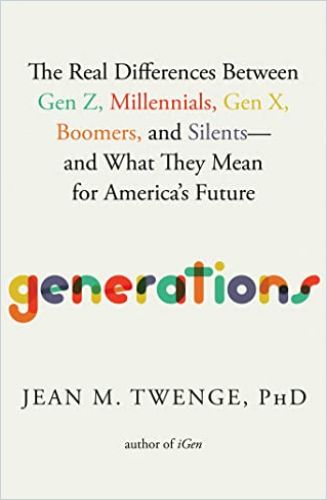Psychology professor Jean Twenge applies prodigious research to exploring the differences between generations.

Different Strokes
Psychology professor Jean Twenge uses a persuasive mix of stats, facts, and charts gathered from datasets of 39 million people to demonstrate how new technologies increase individualism and extend the time it takes to grow up. These shifts make each generation distinct from and enigmatic to others and shape future social, political, and economic trends.
Six Generations
Six generations exist in the United States today: silents (born 1925–1945), boomers (1946–1964), generation X (1965–1979), millennials (1980–1994), generation Z (1995–2012), and polars (2013–2029), or alphas. People born in the same generation experience more or less the same culture, Twenge writes. That shared culture shapes the individual personalities of each demographic’s members, leading to generational differences.
Technological change isn’t just about stuff; it’s about how we live, which influences how we think, feel, and behave.Jean Twenge
Big data analyses from 24 datasets and 39 million people show that technology — including innovations in medical care and education — shapes people’s thinking and behavior and, thus, plays a primary role in forming each generation’s unique, shared culture and driving the long-term trends that shape society.
Twenge argues that one notable trend is increasing individualism. The invention and proliferation of home appliances have allowed people to live alone, where once they required a community to handle daily tasks. Another trend is a “slower life trajectory” — taking longer to grow up. A knowledge-based economy requires more education, which pushes back the average age at which people marry and have children.
Silents and Boomers
The silent generation (born 1925–1945) spearheaded the civil rights movement, the feminist movement, and the nascent gay rights movement.
Silents were at the forefront of the changes that created our modern vision of equality, especially around race, gender, and sexual orientation.
Silents were an optimistic generation, Twenge claims. Their large families acted as buffers against mental health issues. The fertility rate for silents peaked in 1957 with 3.8 children per woman. The fertility rate in 2020 was 1.64 children per woman.
The boomer generation (1946–1964) shifted the focus of American culture toward individual choice. Television and the birth control pill drove this shift.
Boomers lived through the racial desegregation of schools, the 1964 Civil Rights Act, and President Lyndon Johnson’s “War on Poverty,” which ushered in Medicare, Medicaid, and Head Start. From 1992 to 2016, every United States president was a baby boomer.
Twenge notes that boomers struggled much more with depression than their parents did. Deaths due to drug overdoses and suicide rose dramatically once the baby boomer generation began moving past middle age. As new technologies facilitated automation and globalization, income inequality between blue-collar workers and those with jobs in the “knowledge economy” increased.
Gen X and Millennials
Generation X (1965–1979) embraced extrinsic rewards such as status and prestige. Gen Xers were not the first “latchkey kids,” but their mothers worked more than previous generations, and after-school programs did not become common until the 1990s. Every latchkey kid watched the same three television networks because cable TV did not yet exist.
Gen X is the middle child of generations.
Gen X’s childhood was analog, but their adulthood was digital. Gen Xers established YouTube, Yahoo, Google, eBay, PayPal, Twitter, and other major tech companies. Gen X does not trust government or institutions — from medicine to media.
Millennials’ (1980–1994) focus on self-esteem made millennial teens happier than their gen X predecessors, Twenge explains. Millennials are digital natives; social media shaped their politics.
From advice to self-esteem encouragement, the culture told millennials to feel good about themselves no matter what.Jean Twenge
Millennial young adults own homes at about the same rate as boomers did at their ages, and they have lower poverty rates than gen X or boomers did when they were young adults. Millennials date and marry less than previous generations.
Gen Z and Polars
Gen Z (1995–2012) is diverse racially and ethnically, with more Black, Hispanic, Asian, and multiracial individuals in the cohort than any previous generation. As teens, gen Zers drink less, fight less, and crash fewer cars than any previous generation.
The news is not all good, however: A 2019 study found that one in three gen Zers were clinically obese, rates of clinical depression doubled from 2011 to 2021, and school loneliness rose in 36 out of 37 countries from 2000 to 2018. Twenge notes that suicide rates doubled for teens and tripled among kids between 2007 and 2019. Physical inactivity, depression, and loneliness increased dramatically after 2012, the year when 50% of American adults owned a smartphone, and three out of four teens used social media daily.
The polars (2013–2029) suffer fewer severe and fatal injuries than previous generations. They might be the most economically advantaged generation in decades.
Polar children are less likely than ever to be injured, but more likely than ever to get little exercise and to be overweight.Jean Twenge
Smartphone and tablet use is increasing, with eight-to-twelve-year-olds spending an average of 5.5 hours daily on screens. One in five preschoolers and one in four elementary schoolers barely exercise. This generation experiences a 26% increase in overweight two-to-five-year-olds.
The Future
As gen X and millennials take over from retiring boomers, flexible work will become the default — at least among white-collar workers.
In 2020, the US fertility rate was below replacement level. With gen Z reporting little desire to have children, the birth rate will continue to decline. This shift could bankrupt the social security system, increase loneliness, and decrease innovation.
Political polarization is increasing. Women and urban, college-educated people skew more liberal; men and rural, high-school-educated people skew more conservative.
Unique Cohorts
San Diego State University psychology professor Jean Twenge — who also wrote iGen and Generation Me — backs her assertions about the distinctive characteristics of each American generation with intensive research. She asserts that technology is a significant creator and definer of generational traits. Twenge’s style is direct and readable. She structures her chapters such that you don’t need to read every word to gain applicable insights into the generations. While her data is robust, Twenge does not drown readers in statistics. She gives her numbers human meaning, using them to describe each cohort’s work, romance, politics, economics, leisure preferences, and habits. Twenge’s perceptions are a must-read for marketers, researchers, politicians, and students.












